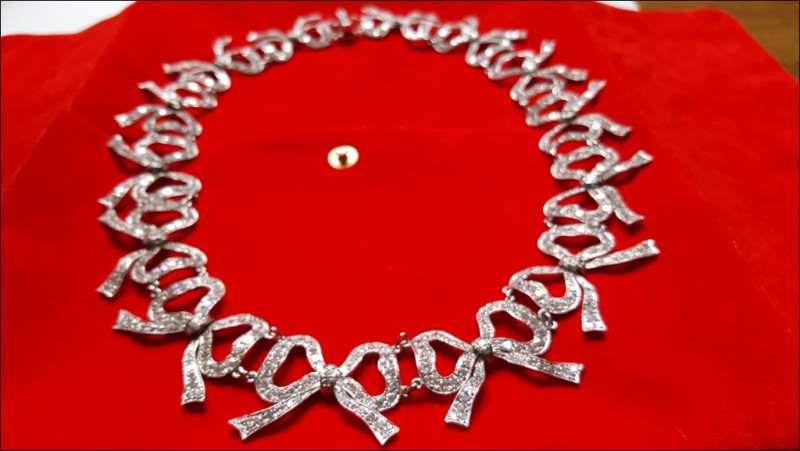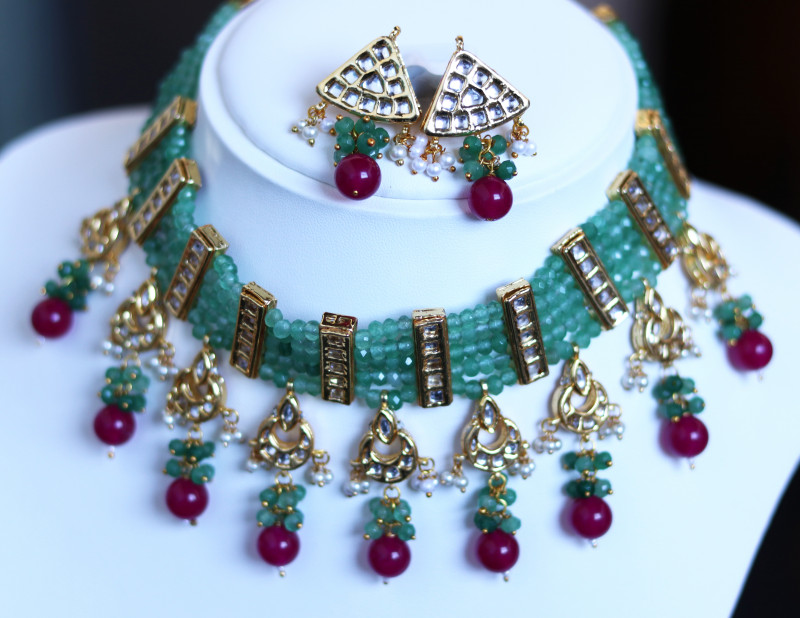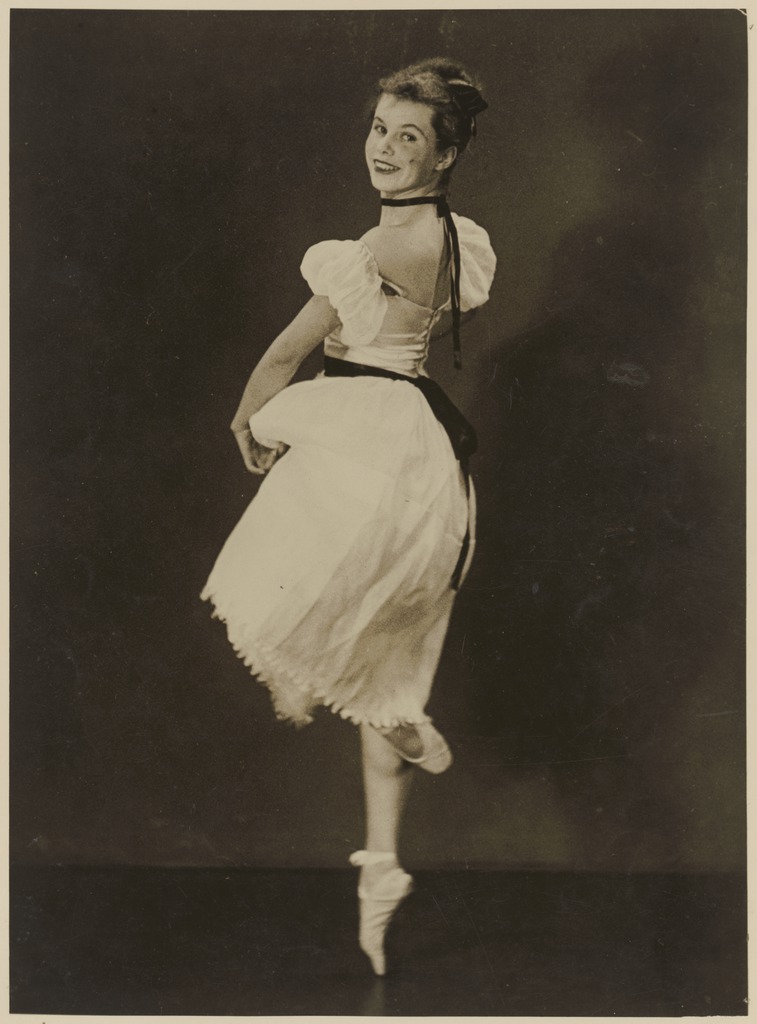
Styles de collier ras du cou : types, significations et histoire
 Les colliers ras du cou sont un accessoire polyvalent, avec des styles et des matériaux adaptés à chaque personnalité. Alors que les tendances des années 90 ont refait surface ces derniers temps, une myriade de styles de colliers ras du cou sont revenus au premier plan de la mode.
Les colliers ras du cou sont un accessoire polyvalent, avec des styles et des matériaux adaptés à chaque personnalité. Alors que les tendances des années 90 ont refait surface ces derniers temps, une myriade de styles de colliers ras du cou sont revenus au premier plan de la mode.
Mais les chokers sont-ils à la mode ? Nous pensons qu'ils sont toujours à la mode. Bien que beaucoup les associent uniquement au grunge des années 90, les chokers sont apparus et disparus sous les projecteurs depuis des centaines d'années.
Aujourd'hui, nous allons passer en revue les types de chokers et leur signification, ainsi qu'un peu d'histoire et d'inspiration pour votre prochain moment de choker élégant.

Qu'est-ce qu'un collier ras du cou ?
Un collier ras du cou est un collier court, généralement de 36 à 40 cm de long, qui s'ajuste parfaitement autour du cou ou repose à la base de votre cou. En ce qui concerne la taille d'un collier ras du cou, la plupart recommandent une taille minimale permettant de passer un doigt entre le collier et votre cou.
Quelle est la différence entre un collier et un tour de cou ? Bien que le terme « collier » ne soit plus aussi largement utilisé aujourd'hui, il fait référence à un autre collier court qui s'ajuste étroitement autour du cou, plutôt qu'à la base du cou. Les colliers ras de cou sont généralement plus courts que les tour de cou, mais il s'agit plus d'une différence sémantique qu'autre chose.

Que représente un collier ras du cou ?
Les colliers ras du cou ont eu de nombreuses significations au fil du temps, de la protection au statut social. De nos jours, les colliers ras du cou symbolisent généralement le non-conformisme ou la rébellion.
Certains experts ont évoqué la dualité qui se cache derrière le symbolisme du collier ras du cou. La créatrice de bijoux vintage Susan Caplan a déclaré au Financial Times : « Le collier ras du cou est associé à tout, du pouvoir et de la violence à la féminité et à la richesse. »
Surtout avec leurs liens modernes avec les styles subversifs des années 70 et 90, les colliers ras du cou évoquent à la fois des sentiments de défi bourru et de féminité douce — pensez aux colliers noirs ornant le cou des jeunes ballerines dans les peintures de Degas.
Le symbolisme du style collier ras du cou a évolué et continuera probablement d’évoluer.
Types de colliers ras du cou
Les colliers ras du cou sont disponibles dans toutes les couleurs et matières, chacun évoquant des significations ou des sentiments différents. Ci-dessous, nous mettrons en évidence les nombreux styles de colliers ras du cou différents, en commençant par la vaste catégorie des styles de colliers ras du cou en tissu.

Collier ras du cou en tissu
Contrairement à d'autres accessoires, les colliers ras du cou sont généralement fabriqués à partir de textiles, notamment de velours, de dentelle, de ruban, de daim ou de cuir. Un simple velours noir est un classique, que vous pouvez rehausser en y attachant une breloque ou un pendentif pour une ambiance sorcière ou victorienne.
Bien sûr, vous pouvez enrouler n'importe quel tissu autour de votre cou, en terminant par un nœud sur le devant pour dire à tout le monde que oui, vous êtes le présent.
Une option bohème ou western est un châle en cuir marron (ou en tissu plus épais), éventuellement rehaussé d'un peu de turquoise pour un style américain de pointe.
Les tissus complexes ou transparents comme la dentelle apportent un air de fantaisie et de flirt, à la fois couvrant et révélateur.

Collier ras du cou en or
Les colliers ras du cou en or sont souvent constitués d'une seule chaîne en or, et même les chaînes varient : corde, câble, maille cubaine, la liste est longue. Plusieurs chaînes ajoutent de la dimension et du drapé. Les couleurs peuvent être plus chaudes comme l'or rose et l'or jaune ou plus froides comme l'or blanc.
Un collier ras du cou en or peut être en or massif, plaqué or ou rempli d'or . En termes de caratage , les colliers ras du cou en or 14 carats sont recommandés pour leur durabilité et leur prix abordable.
Vous pouvez toujours ajouter une touche d’éclat avec des pierres précieuses, des pendentifs ou des perles !

Collier ras du cou en argent
Les colliers ras du cou en argent sont similaires à ceux en or, avec leurs différentes chaînes et accessoires. L'argent sterling est le type le plus populaire, offrant longévité et durabilité à un prix abordable.
Si vous avez une pierre précieuse que vous souhaitez mettre en valeur, les colliers ras du cou en argent sont un excellent support neutre, permettant à la pierre précieuse d'occuper le devant de la scène. Les colliers ras du cou en argent sont également plus discrets, parfaits pour un style plus décontracté ou minimaliste.
Vous vous sentez d'humeur particulièrement rebelle ? Oubliez les « règles » de la mode en mélangeant des bijoux en argent et en or !
Vous pouvez également opter pour d’autres métaux comme le tantale , le titane, le tungstène ou le platine.

Collier ras du cou en perles
Les colliers ras du cou en perles peuvent être aussi simples qu'un seul point focal en perles ou aussi élaborés que des rangées de perles superposées à la manière de Coco Chanel.
Un collier ras du cou à un seul rang de perles évoque le style classique des années 50 ou 60 de style Mad Men . En revanche, un collier avec une à trois perles est un superbe look moderne et minimaliste.
Si les bijoux en perles véritables dépassent votre budget, des perles en verre ou en plastique d'aspect similaire sont une alternative économique.

Collier ras du cou en diamant
Tout comme les colliers ras du cou en perles, les colliers ras du cou en diamants sont un classique élégant, mais ils sont encore plus brillants. Pour une approche plus simple, vous pouvez opter pour une chaîne ultra fine avec un seul diamant « flottant ».
Beaucoup choisissent un collier ras du cou classique avec des diamants tout autour, qui rehausse instantanément n'importe quel look, ou une bande épaisse incrustée de diamants. De plus, vous pouvez opter pour des diamants entièrement blancs ou mélanger et assortir des diamants de couleur.
Les colliers ras-du-cou en diamants drapés sont particulièrement élaborés, évoquant souvent le style gothique. Un exemple récent qui a fait l'objet d'une controverse est le collier ras-du-cou en diamants Cartier du Maharaja de Patiala porté par Emma Chamberlain au Met Gala 2022.
Autre exemple, fictif cette fois, le collier ras du cou en diamants spectaculaire et désormais emblématique que Nicole Kidman portait dans le film Moulin Rouge de Baz Luhrmann en 2001. (Fait amusant : Stefano Canturi a conçu ce collier avec 1 308 diamants, soit 134 carats !)

Collier ras du cou tatouage
En nous éloignant des diamants opulents, nous avons le collier ras du cou « tatouage », un véritable incontournable des années 90. Ce collier ras du cou était le plus souvent un modèle en plastique noir extensible (ou en fil de pêche !) ressemblant à de la dentelle. Il s'est rapidement étendu à d'autres couleurs, épaisseurs et ajouts comme des breloques et des perles.
Le nom « tatouage » vient de la ressemblance du tour de cou avec un tatouage populaire en fil de fer barbelé enveloppant le biceps, comme celui de l'actrice Pamela Anderson.
Les célébrités et les médias ont contribué à populariser les colliers ras-du-cou tatoués auprès des adolescents et des préadolescents. Vous verrez les stars de Buffy contre les vampires, Sabrina l'apprentie sorcière et Elle est trop bien, toutes portant des colliers ras-du-cou tatoués. À l'époque, ces colliers ne coûtaient que 0,50 $.
Les colliers ras du cou à tatouage restent un incontournable pour de nombreux jeunes adultes. Leur prix très abordable et leur diversité de couleurs (du vert fluo, ça vous tente ?) en font un incontournable pour les jeunes branchés.

Colliers ras du cou indigènes
Le style de collier ras du cou a une signification particulière dans de nombreuses cultures indigènes.
Un exemple est le collier amérindien « en os » ou « en pipe à cheveux », qui est généralement composé de piles de perles horizontales interceptées par des perles verticales, attachées avec du cuir dans le dos. Ces colliers étaient portés pour se protéger pendant les combats afin de protéger la veine jugulaire des attaques.
Un deuxième exemple est celui des anneaux métalliques rigides enroulés ou empilés, que l'on retrouve dans certaines cultures asiatiques et africaines , comme ceux portés par les femmes dans la culture birmane Kayan.
Les colliers et ras-du-cou Maasaï sont un autre style africain, qui présente des perles élaborées et colorées.
Ceci n'est qu'un aperçu des nombreux styles de colliers ras du cou indigènes, dont beaucoup jouent un rôle dans l'histoire du collier ras du cou.
Histoire des colliers ras du cou
Des preuves archéologiques montrent que les gens portent des colliers depuis plus de 120 000 ans. L'un des premiers exemples est le collier ras du cou datant de 2600-2450 av. J.-C. retrouvé enterré auprès de la reine Puabi d'Ur.
Comme c’est souvent le cas, la mode n’était pas seulement décorative dans l’Antiquité : elle était souvent protectrice.
Les accessoires tels que les colliers ras-du-cou couvraient les parties du corps particulièrement vulnérables, comme les colliers en os portés par les Amérindiens mentionnés plus haut. Les colliers protecteurs étaient également portés par les femmes nobles du Moyen-Âge pour se protéger de la peste bubonique.
La signification religieuse a également joué un rôle, comme les colliers ras du cou en or de l'Égypte antique destinés à imiter la peau dorée du dieu solaire égyptien, Râ. Les Européens du Nord portaient également des anneaux de cou vers 3000-1000 avant J.-C. pour imiter ceux des dieux celtiques.
 Sur la photo ci-dessus : Anne Boleyn, reine d'Angleterre, probablement un portrait d'une jeune femme à la française | Crédit photo : Ann Longmore-Etheridge, Flickr
Sur la photo ci-dessus : Anne Boleyn, reine d'Angleterre, probablement un portrait d'une jeune femme à la française | Crédit photo : Ann Longmore-Etheridge, Flickr
Colliers ras du cou des années 1500 à 1800
L’idée de porter des colliers ras-du-cou pour se protéger, notamment au combat, a commencé à être associée au danger. Cette association est devenue moins littérale – bien que rétroactivement ironique – lorsque la popularité des colliers ras-du-cou en Europe nous a donné sans doute le collier royal le plus célèbre : celui d’Anne Boleyn vu dans son portrait du XVIe siècle, peu avant sa décapitation en 1536.
Le collier ras du cou d'Anne Boleyn était composé d'un long collier de perles, agrémenté d'un pendentif monogramme « B », bien avant que les colliers avec nom personnalisé ne deviennent populaires dans les années 1980.
En Inde, des portraits datant de 1526 à 1761 représentent des hommes et des femmes couverts de pierres précieuses, en commençant par le cou avec des colliers ras du cou et en les superposant les uns aux autres — y compris celui de Mumtaz Mahal, dont le mari a construit le Taj Mahal comme tombeau.
Ce style s'est répandu en Europe au cours des Lumières (1685 à 1815), aidé par des nobles comme Marie-Antoinette avec son nœud en ruban et ses colliers ras du cou en diamants.
Au lendemain fatal de la Révolution française (période de la « Terreur »), les femmes françaises portaient des colliers ras du cou à ruban rouge en souvenir des 27 000 personnes qui ont perdu la vie.
Au XVIIIe siècle, les adolescentes britanniques ont commencé à porter des colliers ras-du-cou pour se moquer des Français, tandis que les prostituées françaises ont adapté ce style en un collier ras-du-cou à ruban noir pour identifier leur profession. Les ballerines, qui étaient stigmatisées de la même manière que les prostituées à l'époque, ont également adopté le collier ras-du-cou à ruban noir.
Au XIXe siècle, les colliers ras-du-cou larges ont gagné en popularité après qu'Alexandra du Danemark, princesse de Galles à l'époque, ait commencé à les porter, soi-disant pour cacher une cicatrice au cou. Sa belle-mère, la reine Victoria, a également adopté ce collier.
 Sur la photo ci-dessus : Moya Beaver dansant en costume avec un collier porté dans les productions du Lightfoot-Burlakov First Australian Ballet, vers 1935 | Crédit photo : Bibliothèque nationale d'Australie de Canberra, Australie ; domaine public
Sur la photo ci-dessus : Moya Beaver dansant en costume avec un collier porté dans les productions du Lightfoot-Burlakov First Australian Ballet, vers 1935 | Crédit photo : Bibliothèque nationale d'Australie de Canberra, Australie ; domaine public
Colliers ras du cou modernes : des années 1900 à nos jours
Les colliers ras du cou sont apparus dans les années 1900 à des moments charnières du changement sociétal.
Dans les années 1920, les douairières britanniques portaient des colliers ras-du-cou plus formels, tandis que d'autres portaient des colliers ras-du-cou « à plastron » ou de longs colliers de perles enroulés autour pour former un ras-du-cou partiel. Le mot « choker » en tant que style de collier est également apparu dans les années 1920.
Pendant la Grande Dépression (années 1930) en Amérique, de simples colliers noirs étaient parfois portés comme symboles du lesbianisme secret.
La « mode douairière » a été relancée par les jeunes femmes américaines dans les années 1940, comme le rapporte le magazine Life en 1944.
Dans les années 1970, les hommes ont remis au goût du jour les colliers ras-du-cou. Les gros colliers ras-du-cou à pointes du mouvement punk ont également contribué à cette tendance, qui reflète les changements sociétaux plus larges dans l'expression du genre. Des célébrités masculines comme David Bowie, John Lennon et Mick Jagger ont contribué à dynamiser cette tendance.
De même, des célébrités masculines comme Lenny Kravitz et Prince ont rejoint les célébrités féminines pour populariser à nouveau les colliers ras du cou dans les années 1990.

Quel style de collier ras du cou préférez-vous ?
Vous avez maintenant les connaissances nécessaires pour décider quel type de collier ras-du-cou vous devriez porter. Que vous vous inspiriez des célébrités avec un collier ras-du-cou en diamant de haute couture, que vous fassiez travailler vos muscles avec un modèle fait maison ou que vous optiez pour un simple ruban, les options de colliers ras-du-cou sont apparemment infinies.
Les meilleurs colliers ras du cou sont ceux qui vous permettent de vous sentir au mieux de votre forme !
Prête à magasiner ? Parcourez notre collection de colliers ras du cou dès aujourd'hui !
Rechercher le Fashion Encyclopedia
Enchères associées
Articles Liés
Comment acheter des bijoux sur Internet. Il existe de nombreux types de perles. Ce sera à vous de déterminer par où vous voulez commencer, toutes les perles de pierres précieuses authentiques ou si vous utiliserez également des perles de verre « artificielles » ainsi que des perles en or et en argent.
10th Apr 2019
Un guide pour acheter des opales en vrac pour la fabrication de bijoux. Les doublets et les triplets sont parfaits pour fabriquer des bijoux, mais il y a des facteurs dont vous devez être conscient.
3rd Oct 2019
L'opale peut être coupée et polie pour s'adapter à votre bague ou à votre pendentif
8th Apr 2019
Derniers articles
Le titane est un métal de joaillerie très apprécié, connu pour sa légèreté, sa durabilité et son prix abordable. Apprenez tout sur le titane, comment il se compare à des métaux similaires et les avantages et inconvénients des bijoux en titane.
7th Feb 2023
Apprenez tout sur les bijoux en tungstène : de leur histoire et de leurs utilisations à leur durabilité et à leur entretien. À la fin de notre guide, vous saurez si le tungstène est fait pour vous !
7th Feb 2023
Vous souhaitez ajouter des bijoux intemporels en or blanc à votre collection d'accessoires raffinés ? Voici tout ce qu'il y a à savoir sur l'or blanc sophistiqué !
29th Jan 2023




